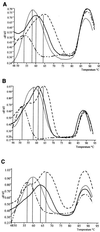Rapid identification of Campylobacter spp. by melting peak analysis of biprobes in real-time PCR
- PMID: 11376061
- PMCID: PMC88115
- DOI: 10.1128/JCM.39.6.2227-2232.2001
Rapid identification of Campylobacter spp. by melting peak analysis of biprobes in real-time PCR
Abstract
We describe rapid PCR-biprobe identification of Campylobacter spp. This is based on real-time PCR with product analysis in the same system. The assay identifies enteropathogenic campylobacters to the species level on the basis of their degree of hybridization to three 16S ribosomal DNA (rDNA) biprobes. First-round symmetric PCR is performed with genus-specific primers which selectively target and amplify a portion of the 16S rRNA gene common to all Campylobacter species. Second-round asymmetric PCR is performed in a LightCycler in the presence of one of three biprobes; the identity of an amplified DNA-biprobe duplex is established after determination of the species-specific melting peak temperature. The biprobe specificities were determined by testing 37 reference strains of Campylobacter, Helicobacter, and Arcobacter spp. and 59 Penner serotype reference strains of Campylobacter jejuni and C. coli. From the combination of melting peak profiles for each probe, an identification scheme was devised which accurately detected the five taxa pathogenic for humans (C. jejuni/C. coli, C. lari, C. upsaliensis, C. hyointestinalis, and C. fetus), as well as C. helveticus and C. lanienae. The assay was evaluated with 110 blind-tested field isolates; when the code was broken their previous phenotypic species identification was confirmed in every case. The PCR-biprobe assay also identified campylobacters directly from fecal DNA. PCR-biprobe testing of stools from 38 diarrheic subjects was 100% concordant with PCR-enzyme-linked immunosorbent assay identification (13, 20) and thus more sensitive than phenotypic identification following microaerobic culture.
Figures

Similar articles
-
Development of a real-time fluorescence resonance energy transfer PCR to identify the main pathogenic Campylobacter spp.Clin Microbiol Infect. 2005 Apr;11(4):281-7. doi: 10.1111/j.1469-0691.2005.01072.x. Clin Microbiol Infect. 2005. PMID: 15760424
-
Development of real-time PCR and hybridization methods for detection and identification of thermophilic Campylobacter spp. in pig faecal samples.J Appl Microbiol. 2005;99(2):292-300. doi: 10.1111/j.1365-2672.2005.02616.x. J Appl Microbiol. 2005. PMID: 16033460
-
Chronic shedding of Campylobacter species in beef cattle.J Appl Microbiol. 2004;97(2):410-20. doi: 10.1111/j.1365-2672.2004.02313.x. J Appl Microbiol. 2004. PMID: 15239709
-
Detection and identification of Campylobacter spp. using the polymerase chain reaction.Cell Mol Biol (Noisy-le-grand). 1995 Jul;41(5):625-38. Cell Mol Biol (Noisy-le-grand). 1995. PMID: 7580843 Review.
-
[DNA sequence for Campylobacter species and their detection and identification by PCR].Nihon Rinsho. 1992 Jul;50 Suppl:353-60. Nihon Rinsho. 1992. PMID: 1404922 Review. Japanese. No abstract available.
Cited by
-
Impact of oxidative stress defense on bacterial survival and morphological change in Campylobacter jejuni under aerobic conditions.Front Microbiol. 2015 Apr 10;6:295. doi: 10.3389/fmicb.2015.00295. eCollection 2015. Front Microbiol. 2015. PMID: 25914692 Free PMC article.
-
Diagnosis and identification of Leishmania spp. from Giemsa-stained slides, by real-time PCR and melting curve analysis in south-west of Iran.Ann Trop Med Parasitol. 2011 Dec;105(8):559-65. doi: 10.1179/2047773211Y.0000000014. Ann Trop Med Parasitol. 2011. PMID: 22325815 Free PMC article.
-
Real-time PCR for detection and quantitation of leishmania in mouse tissues.J Clin Microbiol. 2002 May;40(5):1666-9. doi: 10.1128/JCM.40.5.1666-1669.2002. J Clin Microbiol. 2002. PMID: 11980939 Free PMC article.
-
Rapid detection of Vibrio vulnificus in shellfish and Gulf of Mexico water by real-time PCR.Appl Environ Microbiol. 2004 Jan;70(1):498-507. doi: 10.1128/AEM.70.1.498-507.2004. Appl Environ Microbiol. 2004. PMID: 14711681 Free PMC article.
-
Rapid and accurate identification of coagulase-negative staphylococci by real-time PCR.J Clin Microbiol. 2001 Sep;39(9):3047-51. doi: 10.1128/JCM.39.9.3047-3051.2001. J Clin Microbiol. 2001. PMID: 11526126 Free PMC article.
References
-
- Anonymous. A report of the study of infectious intestinal disease in England. London, United Kingdom: The Stationery Office; 2000.
-
- Bio/Gene Ltd.The Secretary of State for Defence. 21 July 1999. Nucleic acid detection system. Great Britain patent GB2333359A.
Publication types
MeSH terms
Substances
LinkOut - more resources
Full Text Sources
Other Literature Sources
Medical
Miscellaneous

